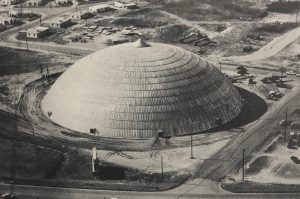The Story Behind the Domes
The LeTourneau domes are a familiar landmark when driving into the heart of Longview from the south. The name of the industrial company has changed several times — it’s now Komatsu. Still, for long-time residents, the domes retain the name of the company founder, who left his mark on this city in many ways. R.G. LeTourneau founded the company that bore his name, invented massive earth-moving equipment and off-shore oil drilling platforms, held hundreds of patents and developed a private Christian technical institute after World War II that evolved into LeTourneau University.
Eventually that company transitioned from family ownership. Its archives ended up at the university — dozens of boxes of records. This summer, along with my co-workers at the Estes Library, I am going through those boxes, categorizing contents, putting the material into archival file folders. It is fascinating work, not a bad way to spend several hours daily in air-conditioned comfort. That’s where I learned the story about those domes from reprinted magazine articles, published in 1954.

I first saw the domes in the summer of 1968, as my parents looked for a house in South Longview, after moving here from New Hampshire. We spent several weeks living with my grandfather in Greggton, until my dad got a job as a sign painter on contract at Texas Eastman. So it made sense to live in the south part of town. My parents bought a house on South Twelfth Street, directly behind the LeTourneau campus. The domes rose above the horizon at the plant on what is now Estes Parkway. The domes were nicknamed by locals as “Mae Wests,” after the voluptuous movie star.
It started with a single dome, officially called a “semisphere,” and completed 65 years ago. Construction began with a 94-foot steel pole in the center with a cone on top that could be raised or lowered for ventilation. A ring of aluminum sheets was bolted and raised around the pole. That was followed by another set of larger rings. Construction continued downward until the last sheet of rings reached the ground, with the lowest ring secured to a foundation ring of concrete. Once completed, the center pole could be removed because it was no longer necessary for support. Eventually, there were five domes at the LeTourneau factory.
According to the articles I found in a musty file folder, each dome covered more than 70,000 square feet of floor space and nearly 3.3 million cubic feet of enclosed space. The aluminum sheets weighed 182,500 pounds. The peak is 85 feet high, and the dome’s diameter equals a football field, at 300 feet. The dome could accommodate 12,000 people, and the design was promoted as a cost-effective way to build something for a variety of uses: civic centers, aircraft hangars, indoor athletic facilities, etc. Evangelist Billy Graham, a friend of Mr. R.G. (as he was known) provided the impetus. Graham wanted a portable building for large-scale gatherings, one of which LeTourneau built in 1940 in Toccoa, Georgia, where the company also had a plant.
The semisphere doesn’t seem to have caught on as a building technique, despite Mr. R.G.’s efforts. Another file folder contained proposals to build semispheres for the U.S. military. They were relatively inexpensive to build — the original LeTourneau dome cost less than $4 a square foot, in 1954 money. Undeterred, LeTourneau created all-steel homes for his workers, one of which was restored last year in Peoria, Illinois, where he once had another plant. His creative genius, as well as his deep Christian faith, are unquestioned, even if sometimes he was far ahead of his time.
I once spent a summer working for a father-and-son inventor duo in the Texas Hill Country. The father had been working on an automated clothing iron for three decades, while the son had patented a clip that kept hubcaps from falling off — back when vehicles had hubcaps. Inventors think differently than common folks like me.
One of the five LeTourneau domes was flattened by a tornado almost exactly two years ago, so four remain. Komatsu is expanding but apparently is not planning to build another dome. More than 500 workers are still employed there, and the two remaining domes still dominate the South Longview landscape, 65 years after the first one was built.
Leave a reply
Fields marked with * are required











